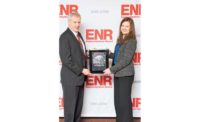By its own admission, Kansas City, Mo.-based designer Burns & McDonnell can be a bit of a plodder when branching into new practice areas, a tendency it says sometimes requires patience from management.
But it's a proven model. Rather than diversify by acquisition, the employee-owned firm cultivates expertise from within. "Organic growth allows us to maintain our culture," says Scott Newland, general manager for the firm's Chicago office. "Instead of attempting to assimilate large groups of employees over short periods of time, we hand pick the best of the best."
When the right leadership, talent and projects finally align, new divisions are born—and they hit the floor running.
In November 2011, the firm restructured its 250-employee infrastructure group into separate water infrastructure and surface transportation infrastructure divisions. The following June, the Missouri Highways and Transportation Commission selected Burns & McDonnell as designer for the $125-million I-64 Daniel Boone Bridge, a replacement structure spanning the Missouri River between St. Louis and St. Charles counties and the firm's largest Midwest project last year.
Burns & Mac, as employees call it, currently is operating at full throttle across 11 operating divisions, from energy and environmental to water, aviation, transmission and distribution. In April, the firm completed a 2011 initiative to add 1,000 employees to its roster—500 of them in Kansas City—eight months early, pushing its staff total past 4,000.
The engineering firm attributes recent growth to projected demand for large-scale infrastructure projects and capital improvements among public- and private-sector clients, particularly in Kansas City, where it currently is assisting Kansas City Water Services Dept. in implementing a $4.5-billion, 25-year plan to reduce and eliminate overflows into the metropolitan area's sewer system.
Opportunities also are opening up in other sectors. A December Environmental Protection Agency ruling on emissions requirements for power houses operated by universities and industrial facilities will classify thousand of boilers as sources of hazardous air pollutants, says Breck Washam, general manager for the firm's St. Louis office. "A few years back, we saw what was happening with large coal-burning powerplants nationwide and said to ourselves, 'It's going to hit industrial and university buildings next,'" he recalls. "Nearly half our work in St. Louis involves energy, so we already have the expertise in place."
Meanwhile, its Chicago office is focusing on projects involving power transmission and distribution. In addition to adding redundancy to systems—the result of high-profile power failures in California and New York City—the office is engineering natural gas-fueled reciprocating engines to supplement energy generated by wind farms. "The wind isn't always blowing," says Newland. "Engine plants provide a clean alternative power source when it isn't."
Newland believes being in the right market at the right time only partially accounts for the firm's continued growth. "As a 100% employee-owned company, we're extremely competitive," he says. "This isn't an instance of 5% of employees holding 85% of ownership. Quite the opposite, in fact. No one owns more than 1%."







Post a comment to this article
Report Abusive Comment